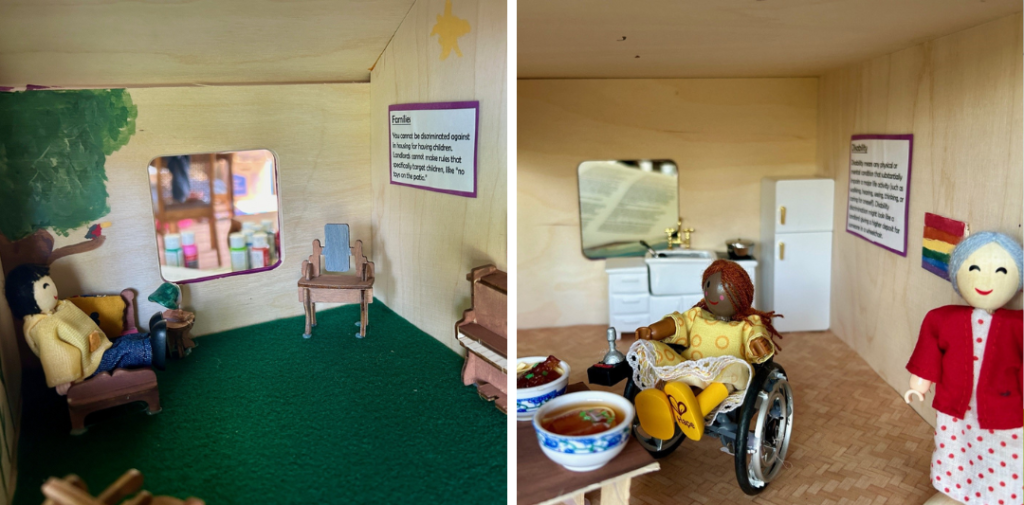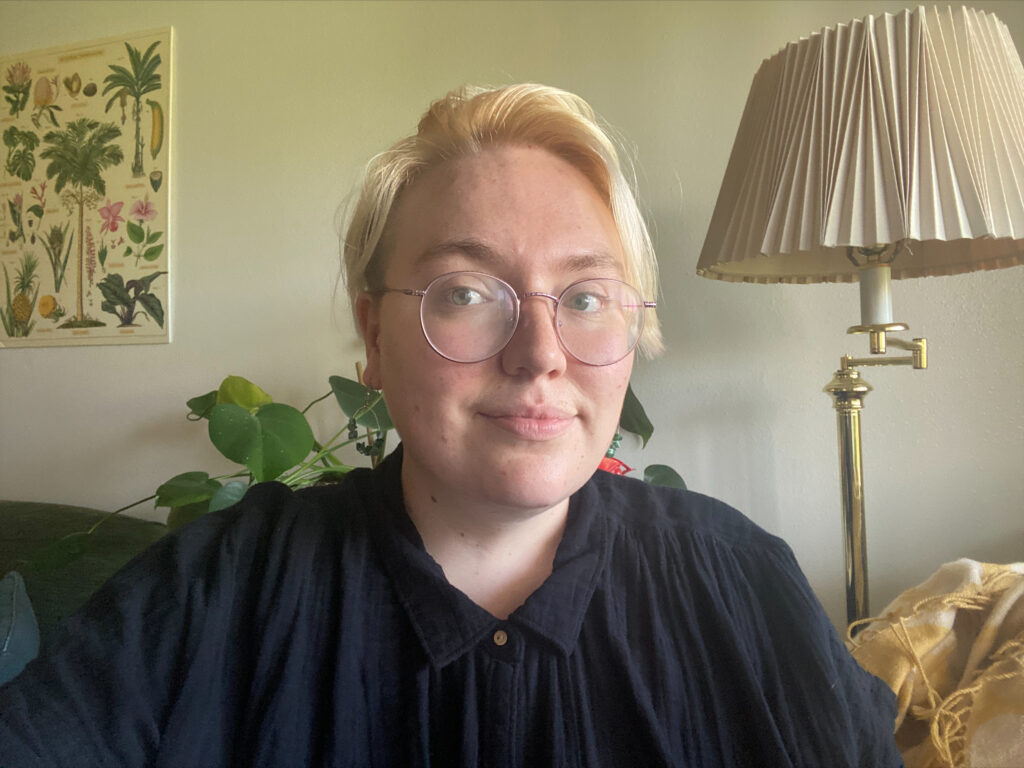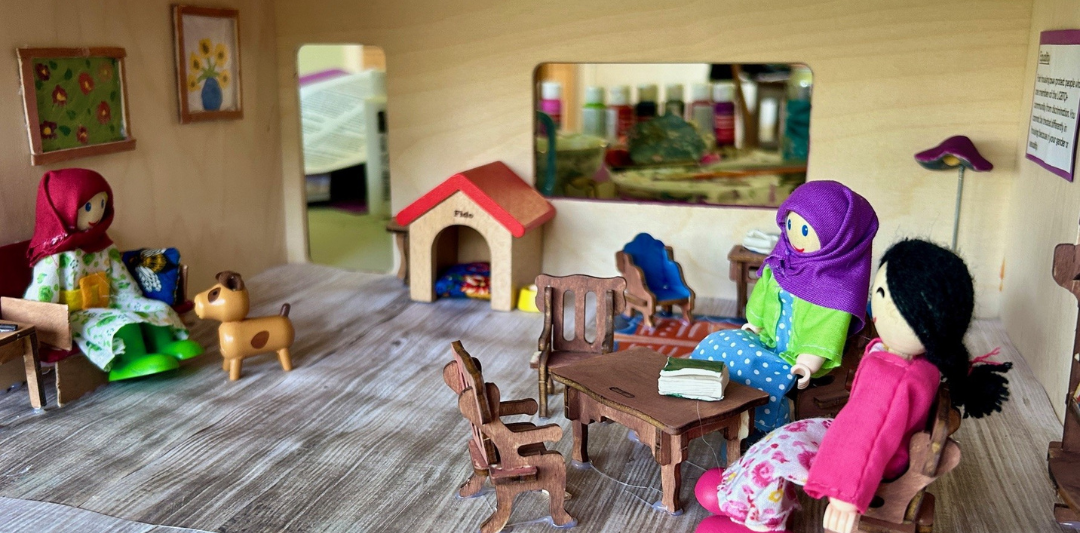Written by Mel Keller, (she/her), Education and Outreach Coordinator
May 29, 2024
Introduction
Each April, we celebrate and honor the Fair Housing Act which was passed in 1968. This federal law makes it illegal to discriminate in housing based on protected classes, and it covers all residents in housing across the United States. In honor of Fair Housing Month in 2024, staff at FHCO built an interactive tool to help children and youth engage with fair housing concepts and terminology in an accessible format—a dollhouse. What we are calling the Fair Housing Dollhouse is a celebration of diversity, community engagement, and education as key components in preventing discrimination in housing. Featuring five rooms and a rotating cast of characters, including assistance animals, the Fair Housing Dollhouse aims to use imagination and pretend play to engage with complex topics like discrimination, institutional racism, and historical inequalities.
Fair Housing Law
Fair housing law is a body of law that covers the rights of individuals in the rental, sale, and financing of a home. The Fair Housing Act of 1968 was passed on April 11, one week after the assassination of Rev. Dr. Martin Luther King, Jr. Throughout the 1960s, housing had become a major focal point of the Civil Rights movement with Dr. King moving his family to Chicago in 1966 to take part in the Chicago Freedom movement. Joining with activist Albert Raby, King and other organizers shifted their focus to de facto segregation in northern cities like Chicago. Segregation in housing was a major issue, and throughout the summer of 1966 marches and demonstrations were held in all-white neighborhoods and in front of banks and mortgage lenders to protest the redlining that kept Chicago’s Black and white communities separated. During these campaigns, organizers developed the first forms of fair housing testing, where Black organizers would go into real estate offices in all-white neighborhoods and receive different responses from the white organizers who asked the same questions. Even before testing was used by national fair housing organizations and the Department of Housing and Urban Development in fair housing enforcement, Dr. King, Al Raby, and other organizers such as the Rev. Jesse Jackson understood that highlighting the hypocrisy of mortgage lenders and financial institutions would provide material evidence of the type of de facto discrimination that existed in northern cities.
In August of 1966, organizers met with Chicago Mayor Daley to discuss solutions. The Chicago Housing Authority promised to build more public housing, and the Mortgage Banks Association promised to not partake in redlining or other forms of discrimination against potential Black loan applicants. King called this moment the first step of a longer journey, one that he would not live to see. While versions of what would become the Fair Housing Act had been introduced in Congress throughout the 1960s, it was the most filibustered piece of civil rights legislation, facing pushback from both segregationist congressmen and organizations such as the National Association of Realtors. President Johnson was finally able to push the Fair Housing Act through Congress in the week after Dr. King’s assassination, using the political urgency to address what he saw as the most important piece of civil rights legislation.
Children and complex topics
The history of racial segregation in housing is a complex and multifaceted subject that scholars can spend their entire careers researching. However, the complexity of this issue does not negate the need to introduce these topics to children at a young age. First and foremost, systemic racism and segregation impact children today, whether or not they realize it. Not only are American schools still highly segregated along racial, ethnic, and socioeconomic lines, but Black families are still dealing with wealth inequality and economic injustice that comes out of the lack of homeownership opportunities over the past 60 years. Children of color in particular will have already been introduced to concepts of otherness and discrimination simply by growing up in this country.
In 2020, a study run by Jessica Sullivan, Leigh Wilton, and Evan Apfelbaum found that parents tend to avoid having conversations about race even when research shows that 9-month-olds babies can use race to categorize faces, and 3-year-olds can associate some racial groups with negative traits. In their study, more than 600 participants were asked the earliest age they would talk to children about race, as well as at what age they thought children could understand race as a factor. The study found that adults believe children should be almost 5 years old before talking about race, which can make it more difficult to change children’s existing views on race. As Leigh Wilton, one of the study authors, argued, “If we wait until a child is old enough to ask a tough question about the history of racial violence, then it will be much harder to talk about if there haven’t been any meaningful discussions about race earlier in their lives.”
Adults may feel uncomfortable discussing race with children or may feel that they are unqualified to have such conversations, but toddlers and young children are still engaging with race in the world around them. It is up to parents and educators to engage with children about these topics in age-appropriate ways. Kids understand concepts like difference and unfairness, and to assume that young children don’t process race can be a misconception that can lead to undereducation on these issues.
Play as learning
A strong literature of the value of play has been developed by those who study pedagogy and early childhood cognitive and social developments. In the book Teaching as Inquiry: Rethinking Curriculum in Early Childhood Education, research shows that a child’s own relationships and sociocultural contexts influence their learning processes. Children’s engagement in play can be shaped by their teacher, or can be self-motivated with the teacher acting as a guide or facilitator. Lynn Barnett, a researcher at the University of Illinois at Urbana-Champaign, notes that play can be seen being symbolic and rules-governed, and that it can be easily distinguished from the real world. These attributes of play allow children (and adults) to engage with topics and ideas in a controlled environment, one where experimentation and imagination are key. Using rule-governed play also allows children to engage with social interaction and cues in a safe environment and can be used as a testing space for social and personal rules.
Using the Fair Housing Dollhouse to teach children about diversity
In FHCO’s Fair Housing Dollhouse, children are able to use the dolls, characters, and spaces to interact with rules around familial composition, identity, disability, and community. For example, children may identify with one particular doll, maybe because of the hair color or the outfit the doll is wearing, and that character can interact with others as a proxy for the child themselves. How would this child interact with an adult from a different ethnic or religious background? How might these dolls be related or connected? Rules-governed play can also help children come to terms with existing limitations in the world. For example, if the doll-children have a bedtime, how do the doll-parents enforce bedtime? What about bath time? Or having friends over for a sleepover? By using a dollhouse, children can engage with their own social experiences and play out scenarios, thereby developing skills that will be useful throughout their life.

The diverse cast of characters in the Fair Housing Dollhouse also points to the importance of representation in play. For example, the inclusion of hijabi dolls may prompt a child to ask why these dolls are wearing headscarves. Or, if the child already knows about the importance of wearing hijab for some women, they might explain the reasoning to another doll. Children will often use their own knowledge as the basis for teaching others, allowing them to take on the role of teacher in certain scenarios. The Fair Housing Dollhouse allows children to educate each other on a variety of issues, such as why some people might be in wheelchairs, why families look different to others, or even how historically this type of family might not have been allowed to live in this house.

Other ways FHCO engages with children and youth are through our annual poster contest and our 2023 Fair Housing Quilt. Each year in February, children in grades 1-8 across the state submit designs on a topic related to fair housing. The 2024 theme was, “It’s fun having all kinds of neighbors,” and a pool of volunteer judges help to determine which entry showcases the theme, diverse communities, and representation of protected classes. The winning artist is given a cash prize and has their poster design printed and shared by FHCO across the state. Our 2023 Fair Housing Quilt was a design project where children at libraries and schools across the state were asked to depict their home or community on a fabric square which was then stitched together in a quilt. Along with the Fair Housing Dollhouse, FHCO has made a consistent effort to increase awareness among young Oregonians about how fair housing law protects everyone against illegal housing discrimination.
Engaging with children on a topic like racial discrimination does not have to be particularly in-depth and historical in nature. By using interactive tools such as the Fair Housing Dollhouse, children are given a safe space to ask questions about diversity and even be introduced to more complex topics that tie into the history of the Fair Housing Act and racial segregation in housing. Engaging with a child about why some people might be treated differently than others, does not have to be a college-level course. Rather, the dollhouse can be a neutral arena of play for children to engage with differences, learn about assistance devices for disabilities, or understand how different cultures coexist all around us. As the Fair Housing Council of Oregon grows our educational capacities, we strive to create learning tools that engage people on all levels, and the Fair Housing Dollhouse creates new opportunities for children to be a part of that education.

Mel Keller (she/hers)
Education and Outreach Coordinator
Mel holds two masters’ degrees, one from the London School of Economics in Comparative Politics and one from the University of Oregon in Political Science. She studied how racial discrimination impacted the creation of the American welfare state, as well as how veterans are treated in different countries and how they fit in with social services. Aside from her academic work, she has a background in nonprofit work and union organizing, both of which give her a great perspective to bring to FHCO! She firmly believes that education and knowledge are the best tools to create change.
